 But while America subsequently pursued a strategy of long-range bombers to deliver nuclear weapons, the USSR began a missile program which couldn't be defended against like a squadron of flying planes could be. The genius behind their program was a Soviet engineer named Sergey Korolev (or Korolyov) but known outside a very small circle only as the "Chief Designer." After getting the rockets to work he convinced Nikita Khruschev to pursue the launch of the world's first artificial satellite, and on October 4, 1957 Sputnik was launched. But while most leaders in both countries dismissed it as a ridiculous waste of resources, the public was fascinated and terrified by this newly demonstrated capability of the Russians. It quickly turned into a public relations coup.
But while America subsequently pursued a strategy of long-range bombers to deliver nuclear weapons, the USSR began a missile program which couldn't be defended against like a squadron of flying planes could be. The genius behind their program was a Soviet engineer named Sergey Korolev (or Korolyov) but known outside a very small circle only as the "Chief Designer." After getting the rockets to work he convinced Nikita Khruschev to pursue the launch of the world's first artificial satellite, and on October 4, 1957 Sputnik was launched. But while most leaders in both countries dismissed it as a ridiculous waste of resources, the public was fascinated and terrified by this newly demonstrated capability of the Russians. It quickly turned into a public relations coup. Brzezinski's story-telling skills are superb, and although news from NASA has became fairly mundane, he takes the political intrigue and technological setbacks behind the scenes and turns it into a gripping narrative. You could feel the exhilaration at the successful launch of Sputnik, and the disappointment when the American Vanguard rocket exploded on the launch pad. Alternating back and forth between the Soviets and the Americans, he keeps the information and action flowing fast. If you liked Annie Jacobsen's Area 51 or just enjoy Cold War history this book will become one of your "all-time most favorite books ever," too.














